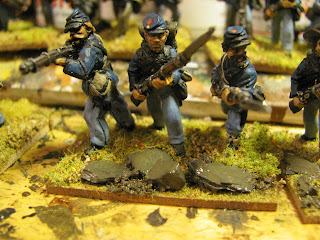Here is a step by step lesson in how I base and flock my ACW figures. These figures have been rebased to fit with the Regimental Fire and Fury ACW rules. My figures were originally based in threes but I liked the idea of having deeper bases to play around with. Also the rebasing gives me a chance to update the painting on a lot of old models painted back in 1997.
In those days my only experience of historical gaming had been 15mm and so I based figures three to a base but in the same pose. Time for a mix up and a change.
I have always been a lazy baser and would speed through basing to spend more time creating masses of troops. Over the years I have developed a simple style of basing that looks good but is very quick and easy to do. I have been asked to share this basic approach to basing so here goes, I hope someone out there finds it useful.
I did a bit of research into American ground colours on a trip to the States and from ACW books. The ground is quite dry looking with a lot of dead grass due to the climate. So first I searched through my vast flock collection to find a suitable 'dry' colour. This will act as the base colour from which to hang everything on.
Over the years I have collected a massive collection of different flock colours. These have been horded from model railway shops and the like. The name of this flock has been lost to history but it had the right colour to it and also I had a large quantity of it. We were off...
Once the three figures were based on their new 45mm x 30mm base (from Warbases), I painted PVA glue on the base and dipped them in the first round of flock.




















































